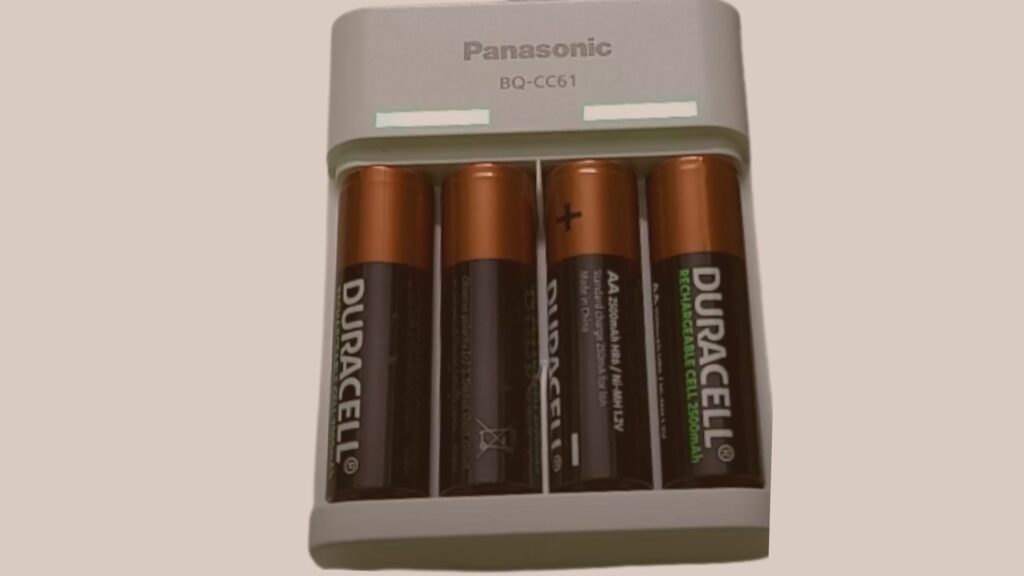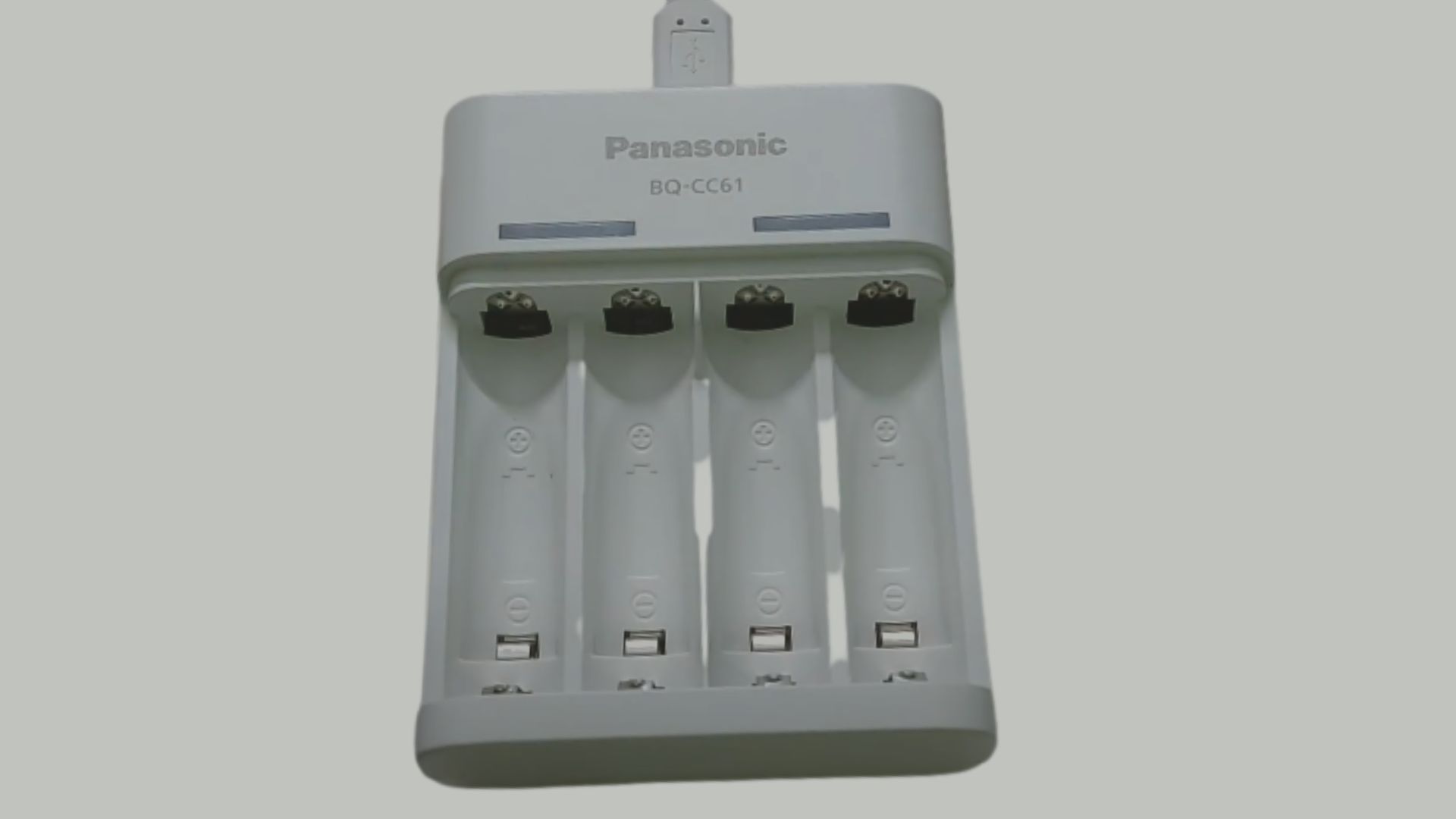Most manufacturers include LED indicators that allow battery chargers to communicate with you. Panasonic is no different.
Panasonic Battery Charger Flashing Lights – Why?
1). Wrong Placement
You must insert the batteries correctly, taking into account the polarity. If you don’t, the batteries won’t charge. A sophisticated charger will let you know that it has failed to charge the batteries by flashing the lights.
2). Status
Chargers can use blinking LEDs to indicate the status. For instance, according to this Panasonic guide, the charger will blink when it checks the battery’s status. This Panasonic BQ CC17KSBA is an example of a charger that analyzes the batteries beforehand. The lights flash during this stage. The charging process will commence soon after.
You can also expect flashing LEDs during and after charging. Whether the charger uses a solid or flashing LED to indicate charging depends on the model. Check the manual if you have questions.
3). Wrong Battery
The lights can flash because you inserted the wrong batteries. Panasonic chargers can only charge rechargeable batteries. If you insert non-rechargeable batteries, the charger will reject them. Expect a similar response to the wrong battery type.
4). Dead Battery
You inserted the correct rechargeable battery. But the battery is dead. Some batteries will show obvious signs of wear and tear, such as swelling and leaks. In other cases, you must test the battery with a multimeter to prove that it has reached the end of its lifespan.
Either way, if the battery cannot accept the charge, the charger will let you know by flashing. Some chargers will successfully charge a faulty battery. But the LEDs will continue blinking, encouraging you to replace the defective battery. Problematic batteries will discharge at a faster rate.
5). High Temperature
High temperatures are bad for batteries. A BCI Failure Mode Study from 2010 found that a 7-degree (Celcius) temperature increment reduced a battery’s life by twelve months. Additionally, University College London highlighted the airline industry’s decision to stop transporting lithium-ion batteries in bulk because batteries could start fires when they overheated.
As such, it shouldn’t surprise you to learn that chargers have LEDs that flash when temperatures are too high. A charger’s lights can blink because the battery is too hot or too cold.
6). Poor Connection
The battery has a poor connection to the charger. This can happen because you did not apply firm pressure while inserting the batteries or the contacts are loose. Contacts can wear out because of prolonged use, mishandling, and corrosion. A charger cannot charge a battery if the battery is loose in its slot.
A charger that can’t charge a battery for any reason will alert you by flashing the indicator LEDs.
7). Dead Charger
The Panasonic charger is defective. Chargers can die because they have reached the end of their lifespan or you mishandled them. Or maybe they encountered a surge from your home’s power supply. The lights will flash because the charger detects a fault. Eventually, the Panasonic charger will stop working.
If the charger is new, and the lights have persisted, the charger has a factory defect or an electronic glitch.
8). Low Voltage
The charger cannot charge the battery because the battery’s voltage is too low. This can happen when you allow a battery to discharge completely.
9). Dirt
The charger can fail to charge the battery because of dirt on the contacts. Dirt or debris interrupts the connection between the battery and charger. The charger will flash because it has failed to charge the battery.
Panasonic Battery Charger Blinking Green – Why?

Usually, a green LED is a good thing. You see it when the battery is charging. But this light is solid and only turns off when the battery is fully charged. A flashing green LED’s purpose depends on the model.
In some cases, it shows the battery’s status. For instance, the charger will flash a certain amount of times when the battery is 80 percent charged or less. Panasonic chargers also flash green because of dirt.
You will see flashing green lights when a Panasonic BQ-CC17SBA charger rejects the battery. This can happen because the battery is dead or you inserted it poorly. But then, you have Panasonic chargers that flash green when the battery is charging.
This LED has numerous meanings. Check the manual to get a concrete explanation for the blinking green light. Don’t expect the green light on every charger to mean the same thing.
How To Fix It?
- If the flashing green light indicates a charging battery, you don’t have to fix it. The flashing green light is a good thing. It shows that your charger is working as expected.
- If you inserted the batteries poorly, take them out and follow the manual’s instructions. Make sure the polarity is correct.
- If the batteries are dead, replace them. Use a multimeter to test them.
- If the contacts are dirty, clean them.
Panasonic Battery Charger Blinking Red Light – Why?
- You inserted a dead battery.
- The battery is non-rechargeable.
- You added an incompatible battery.
- The charger has a defect.
- The charger has detected an error. Maybe the temperature is too high, or the voltage is wrong.
How To Fix It?
- Make sure you inserted the correct battery type. Don’t expect the charger to work with every battery type. For instance, if the charger is only compatible with lithium-ion batteries, it won’t work with NiMH batteries. Use the manual to identify the battery type the charger accepts and buy that battery type.
- Replace the non-rechargeable battery with a rechargeable option.
- Replace a dead battery. Test with a multimeter. If the battery is simply depolarized, I suggest using a 9V battery to fix this issue. Hold the 9V battery’s metal parts against the lithium-ion battery for 20 seconds.
- Replace a defective charger.
- If the temperature is too high, allow the battery to cool before attempting to charge it.
Related Post:

